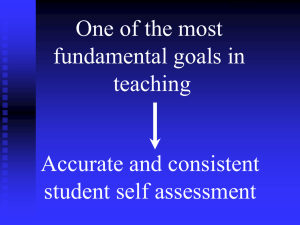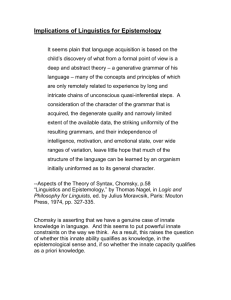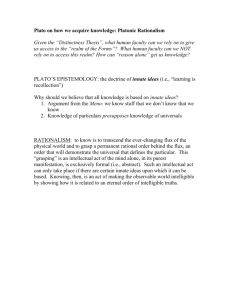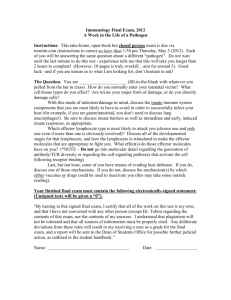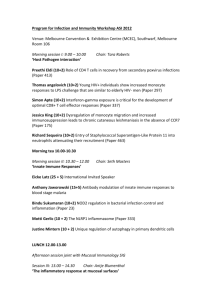since learned behavior is innate, and vice versa, what now?
advertisement
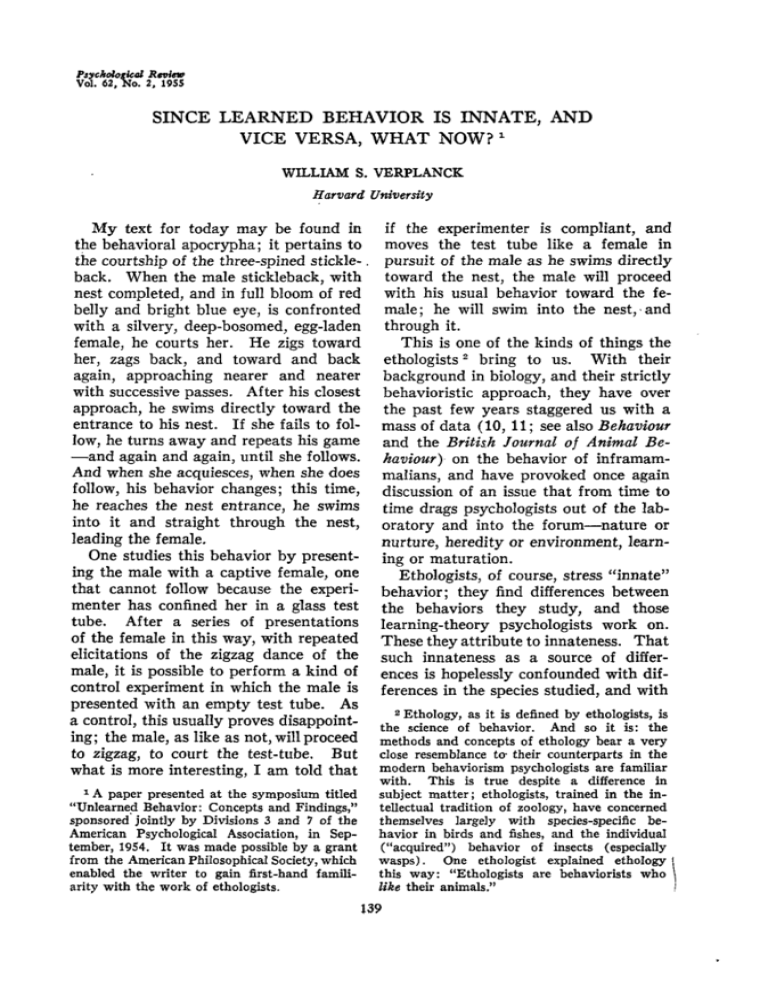
Psychological Reviev Vol. 62. No. 2. 19SS SINCE LEARNED BEHAVIOR IS INNATE, AND VICE VERSA, WHAT NOW?1 WILLIAM S. VERPLANCK Harvard University My text for today may be found in the behavioral apocrypha; it pertains to the courtship of the three-spined stickle-. back. When the male stickleback, with nest completed, and in full bloom of red belly and bright blue eye, is confronted with a silvery, deep-bosomed, egg-laden female, he courts her. He zigs toward her, zags back, and toward and back again, approaching nearer and nearer with successive passes. After his closest approach, he swims directly toward the entrance to his nest. If she fails to follow, he turns away and repeats his game —and again and again, until she follows. And when she acquiesces, when she does follow, his behavior changes; this time, he reaches the nest entrance, he swims into it and straight through the nest, leading the female. One studies this behavior by presenting the male with a captive female, one that cannot follow because the experimenter has confined her in a glass test tube. After a series of presentations of the female in this way, with repeated elicitations of the zigzag dance of the male, it is possible to perform a kind of control experiment in which the male is presented with an empty test tube. As a control, this usually proves disappointing; the male, as like as not, will proceed to zigzag, to court the test-tube. But what is more interesting, I am told that 1 A paper presented at the symposium titled "Unlearned Behavior: Concepts and Findings," sponsored jointly by Divisions 3 and 7 of the American Psychological Association, in September, 1954. It was made possible by a grant from the American Philosophical Society, which enabled the writer to gain first-hand familiarity with the work of ethologists. if the experimenter is compliant, and moves the test tube like a female in pursuit of the male as he swims directly toward the nest, the male will proceed with his usual behavior toward the female; he will swim into the nest, and through it. This is one of the kinds of things the ethologists2 bring to us. With their background in biology, and their strictly behavioristic approach, they have over the past few years staggered us with a mass of data (10, 11; see also Behaviour and the British Journal of Animal Behaviour) on the behavior of inframammalians, and have provoked once again discussion of an issue that from time to time drags psychologists out of the laboratory and into the forum—nature or nurture, heredity or environment, learning or maturation. Ethologists, of course, stress "innate" behavior; they find differences between the behaviors they study, and those learning-theory psychologists work on. These they attribute to innateness. That such innateness as a source of differences is hopelessly confounded with differences in the species studied, and with 2 Ethology, as it is denned by ethologists, is the science of behavior. And so it is: the methods and concepts of ethology bear a very close resemblance to- their counterparts in the modern behaviorism psychologists are familiar with. This is true despite a difference in subject matter; ethologists, trained in the intellectual tradition of zoology, have concerned themselves largely with species-specific behavior in birds and fishes, and the individual ("acquired") behavior of insects (especially wasps). One ethologist explained ethology this way: "Ethologists are behaviorists who like their animals." 139 140 WILLIAM S. VEEPLANCK the degree of experimental restriction on the behavior investigated, goes without saying. Ethologists have, however, stirred up the argument, and one of the features of our cultural heritage appears to be a very strong tendency to take one or another side in it. The discussion shifts its ground, changes its dominant features, but it seems to remain. Fortunately, there are signs that progress is being made toward a solution to the endless chatter. Experimental animals, busily engaged in coping with their environments, seem to be coping with this bit of human activity as well. They seem to be telling us that there is no possible reasonable answer to questions such as "Is this bit of behavior innate?" The dilemma of innate or acquired seems to be one of those categorical pseudo problems that the philosopher Ryle (9) has concerned himself with. Analysis of the variables controlling behavior, such as that presented by Hebb (4), tells us the same thing: it is a logical impossibility to study the innate before studying learning. As we list the criteria proposed for distinguishing the innate from the learned, many examples of learned behavior can be found that satisfy one or more—or most—of the criteria for the innate. Stereotypy, universality of appearance, orderliness, adaptivity, resistance to modification—all these fail, and only one criterion remains: execution of the behavior on its first opportunity to occur, without the possibility of previous learning. How does one rule this out? We are forced into the position of acknowledging that the only criterion for distinguishing between innate and acquired behavior is one that requires us to accept the null hypothesis as proven. We are forced into the position that no meaningful distinction can be drawn between learned and innate behavior, that is, between the stereotyped and highly predictable behavior studied in inframammalians by the ethologists, and the more variable behavior studied in the T maze and Skinner box. We can no more distinguish between behavior that is innate and behavior that is learned than physicists can distinguish between light that is made up of corpuscles and light that is made up of transverse vibrations. Innate and learned must always be assumed to have quotation marks about them. Given this position—the assumption that much the same behavioral laws apply throughout the vertebrate realm (if not further), together with a rigorous experimental approach to behavior—a number of consequences follow. I shall note and illustrate some of these consequences. First, the same classes of experimental variables should control both learned and unlearned behavior,3 and in similar ways. Hence, the same kinds of difficulties should arise in experimental designs aimed at untangling the effects of these variables, whether they are applied to learned or innate behavior. Secondly, the structure of the theory of unlearned behavior and that of learned behavior must prove to be similar if not identical. It should not matter which kind of behavior yields a theory—it should apply to both. That is to say, one theoretical account of causal variables should be found forced by the data, and it should prove applicable to the data of both. And perhaps the same classes of theoretical variables should give the same kind of theoretical difficulties. Thirdly, the behavioral phenomena 3 From this point on, by learned behavior, we will refer to behavior studied by learning theory men; and by unlearned or innate behavior, to behavior studied by ethologists, and so termed by these men, LEARNED AND INNATE BEHAVIOR observed by ethologists in the field should be observable in the T maze and similar apparatus, and those observed in the T maze should be observable in the field. Those who study innate behavior are well advised to look for and control the effects of the variables studied in learning. Conversely, those who study learning may facilitate the accumulation of relevant data by looking for and controlling the effects of the variables that have been considered the preserve of the ethologist. I am not saying that ethologists and psychologists should borrow each other's concepts to apply to their own fields, but rather that there is only one field of investigation, and failure to examine all the concepts developed in that field may serve to delay the development of an ordered and comprehensive body of data. ^- If there were time, we could develop fully each of these points. We could draw the revealing parallels between the series of experiments on generalization gradients in the CR (e.g., 5, 6) and those on the sign stimuli releasing pecking in the gull chick (12). The differences seem to lie in the number of dimensions of the stimulus that must be investigated. Hovland restricts himself to one: metric distance from the point of original conditioning along the body surface. Others have explored response strength along other single stimulus dimensions, such as frequency of a pure tone. Tinbergen and Perdeck, however, are forced by the animal, as it were, to vary the complex stimulus for the pecking response along a series of dimensions that includes those relating to the size, position, and optical properties of the spot on the bill of an adult sea gull, as well as to similar measures of the bill itself and of the remainder of the adult's head. Along each of these dimensions they find what is recognizable as a generalization gradient. To determine these gradients, careful counterbalancing of 141 the order of test stimuli was essential, lest, as in the CR, the response extinguish. We could point out that it does no abuse to the theories now current in ethology to change a term here and there and thereby convert ethological theory into something in large measure almost indistinguishable from 1943 Hullian theory (7), except in its treatment of the variables defining 8HR (some of which it ignores). We could expand the difficulties that ethological and learning theorists have with the concepts of stimulus and response. Both tend to commit a series of equivocations or, more charitably, both tend to gloss over some of the possible distinctions to be drawn between movement-defined and consequence-defined responses (3, 11). More profitably, we may look at some of the contributions that the work of the ethologists may make to behavioral psychology today. After Beach's classic paper, "The Snark Was a Boojum" (2), it may seem a bit unnecessary to stress once again that behavior is a function of species membership, and that we do not have as yet more than the beginnings of a comparative psychology. The neglect of this field has served to let the work of psychologists drift out of the context of that general evolutionary theory that unifies all the biological sciences. We have little to say about the survival value 4 and the taxonomic distribution of behavior. This may or may not be a bad state of affairs. But clearly, in forgetting the comparative approach, we are very sharply limiting the inductive basis of our theories of behavior. To restrict ourselves to the study of one or two species and a short list of en4 Most psychologists are surprised when they learn that the adaptiveness or survival value of a structure or of a behavior is now subject to experimental verification in biology. 142 WILLIAM S. VERPLANCK vironmental variables ensures that miniature theories will remain miniature. The penalty we pay can be evaluated very readily indeed when once we shift from species to species. Armed with our knowledge of rats, we may attempt, for example, to do an experiment on the guinea pig. As soon as we do this, we discover that guinea pigs are not rats. This is not very startling, perhaps, but significant enough when we discover that the food-deprivation-feeding-behavior relationships5 in the guinea pig are sufficiently different from those in the rat that it is all but impossible to recover from the guinea pig the types of relationships between bar pressing and deprivation that we are familiar with in the rat. Here is one area of comparative psychology that has hardly been touched, but one that has many implications, both practical and theoretical. The laws of learning operate within limits determined by the genetic characteristics of the animal. The behavior repertoire and the functional relationships existing among members of the repertoire and between them and the environment are set by the genetic characteristics of the animal, whether they are learned or not. Secondly, we might look toward incorporating into our theories of learning a variable that has been remarkably neglected—in theories if not in practice. This variable is the age of the organism, and the general topic is "the critical period for learning." But with D. O. Hebb and Eckhard Hess among the participants in this symposium, it seems hardly necessary to stress the fact that the acquisition of particular modes of behavior is very much a function of the animal's age, of behavior acquired before the behavior we are studying is c This and several other experimental results described have not yet been reported or published elsewhere, acquired, and of other behavior being acquired, or appearing, at the same time. Thirdly, psychologists have largely set problems to their animals, and examined the incidence of particular pieces of behavior. Starting out with limited interests, we have examined limited sets of variables, both dependent and independent. Ethologists, on the contrary, have often examined somewhat broader causal chains of events, and have not restricted themselves to observing the effects of our sets of independent variables on the responses we like to deal with. To put it another way, ethologists watch everything that animals do, and everything that is happening when they do it. Given the opportunity, animals will emit behavior that is highly adaptive, and integrate it into longer causal chains, still under the control of specific motivating conditions and contingencies of reinforcement. Quite interesting behavioral effects will occur if we but let them. Let me take two examples. In the first case, worked on by 0. R. Lindsley, 20 rats were put on a deprivation schedule that allowed them access to solid Purina chow pellets for just one hour a day. Lindsley placed a number of pellets in the individual cages at the beginning of the hour, and at the end of the hour he took the remaining ones out. The first day was uneventful. There was the rat, there were the pellets, and in went the hand to remove the pellets. On the second day, when the experimenter's hand moved into the cage of one animal, the rat seized a pellet and retreated to the rear of the cage with it. There he held it. He hung on. After taking out the other pellets, the experimenter had to take the pellet from the rat forcibly. On the next day, two or three rats showed this behavior, and by the end of the week, not only were all 20 showing at least this behavior, but some had gone on to seize and carry two or more pellets to the rear, and in / : , ' , ; i • |U , ; j 1 j LEARNED AND INNATE BEHAVIOR many the behavior was set off by simply unlatching the cage door. Reinforced? Interesting? Irrelevant? Some data we now have suggest that this behavior is associated with an increased tendency to run in a running wheel. In the second case, IS rats were trained to bar press in simple wire mesh Skinner boxes. After they were placed on a reinforcement schedule, discrimination training was begun, with five-minute periods of presentation of SD, the positive discriminandum, and five minutes of SA, the negative discriminandum. SA was a two-inch equilateral black cardboard triangle that could be fixed by paper clips to the wire mesh behind the bar of the Skinner box. Under SD conditions, this black triangle was absent. During the first discrimination period with the first failures of reinforcement, most of the animals seized, shook, and bit the bar, and the black triangle too. In most cases this aggressive behavior continued for several minutes; it continued in fact until the triangle was removed from behind the bar, usually by the rat. As soon as the triangle was gone, the animals resumed bar pressing at their normal rates. At the end of a series of such cycles of SD and SA, the majority of the rats, as soon as SA was fixed in place, would approach it, and neatly but vigorously remove it—to get back to work. The effect appeared whether or not reinforcements were forthcoming when SA was removed, although it is not surprising that the behavior was not so neat and efficient when the recurrence of SD did not restore the previous reinforcement schedule. Altogether there was a startling shift from "violent," "aggressive," "emotional" assault to neat, smooth, precise manipulation. Both these cases are the kinds of behavior that ethologists look for, and with which they deal. Both these cases are the kind of behavior that psychologists 143 learn to ignore, or learn to prevent. Perhaps I may be forgiven if I suggest that they should be of some concern and interest to the learning theorist. The next area that might be examined is that of displacement activities—responses usually associated with one drive state that appear when behavior associated with another drive is prevented from occurring, and in conflict situations (1). One mode of behavior that might be classified as displacement activity by the ethologist is the bar biting and bar shaking of our last example. Others are the face washing and general body cleaning—preening—that rats so often vigorously show during extinction, and the cooing and wing beating of the pigeon that occur under the same circumstances. These modes of behavior are familiar enough, but they are very largely associated for us with the extinction of behavior that has led to food and water. It is clear that our animals have behaviors that are not associated with reinforcement by food and water getting, or by shock avoidance. It has now been shown that mice will learn to press bars when the reinforcement is access to a submissive male (which is then attacked), that rats will learn to press bars that release brakes on their running wheels (8) or that permit a female in oestrus to join them in the Skinner box. What behaviors, if any, appear when extinction is carried out with respect to such reinforcements? The ethological work would suggest strongly that we look and see. Perhaps some things that have puzzled us will be clarified. Again, much work has been done with the hoarding of food and water pellets, and of other objects, under experimental conditions involving deprivation of these substances. But what of rats that hoard yellow pencils, pens, paper clips, and envelopes, when they have not had a history of deprivation of food or water, and when such objects have not been 144 WILLIAM S. VERPLANCK associated with food or water? And what of satiated rats running freely about familiar spaces that transport large pieces of favored foods to preferred places, and there eat them, although they eat small pieces on the spot when they get them? And that do the same with their standard food if they are hungry? And that do not hoard it? The psychologist's fixation on a few easily manipulated and already identified experimental variables may seriously limit the power of his generalizations. Let me complete the circle, and close by returning to the behavior described in the beginning, that is, to the stickleback that was conditioned to zigzag to a test tube. When this conditioning was effective, he showed other behavior toward the test tube—behavior that had not been conditioned to it. He led it, you will recall, to his nest, and there he did what he usually does only when a female is behind him: he swam through the nest. I cannot think of a clear-cut case where such a transfer effect occurs in the animals run by psychologists. What is disturbing is that I cannot think of a clear-cut case where such a transfer effect could have been observed in psychologists' animals. Some rather similar behaviors occur to me, and these are ones that have puzzled me as an S-R psychologist. Let us take rats that have run across a grid to food many times, so that their running is asymptotic. If, for the first time, they are now shocked as they cross the grid, they may show no change in their running when the shock occurs. But on the next trial, they may stop short of the grid, and there sniff and poke and peer. The ethologists have much to teach us. ... They suggest that we must observe more species, that we must find new organizations of behavior (that is, new drives), that we must permit more manipulation of the environment by the animal, giving opportunities for phenomena not already in the textbooks to occur—in sum, that we must broaden the inductive basis, the experimental underpinnings, of our theories of behavior. REFERENCES 1. BASTOCK, M., MORRIS, D., & MOYNIHAN, M. Some comments on conflict and thwarting in animals. Behaviour, 19S3, 6, 66-84. 2. BEACH, F. A. The snark was a boojum. Amer. Psychologist, 19SO, 5, 11S-124. 3. ESTES, W. K., et al. Modem learning theory. New York: Appleton-CenturyCrofts, 1954. 4. HEBB, D. O. Heredity and environment. Brit. J. Anim. Bekav., 19S3, 1, 43-47. 5. HOVLAND, C. I. The generalization of conditioned responses: I. The sensory generalization of conditioned responses with varying frequencies of tone. J. gen. Psychol., 1937, 17, 125-148. 6. HOVLAND, C. I. The generalization of conditioned responses: II. The sensory generalization of conditioned responses with varying intensities of tone. J. genet. Psychol., 1937, 51, 279-291. 7. HULL, C. L. Principles of behavior. New York: D. Appleton-Century, 1943. 8. KAGAN, J., & BERKUN, M. The reward value of running activity. J. comp. physiol. Psychol., 1954, 47, 108. 9. RYLE, G. Dilemmas. Cambridge: Cambridge Univer. Press, 1954. 10. SOCIETY FOR EXPERIMENTAL BIOLOGY. Physiological mechanisms in animal behaviour. New York: Academic Press, 1950. 11. TINBERGEN, N. The study of instinct. Oxford: Oxford Univer. Press, 1951. 12. TINBERGEN, N., & PERDECK, A. C. On the stimulus situation releasing the begging response in the newly hatched Herring Gull chick (Larus argentatus argentatus Pont.). Behaviour, 1950, 3, 1-39. (Received for early publication October 20, 1954)
